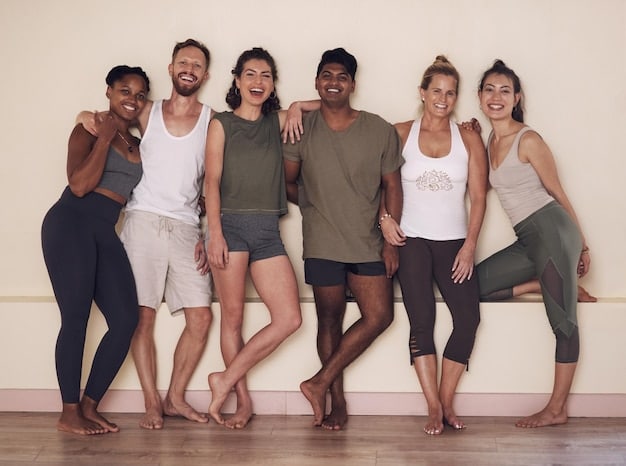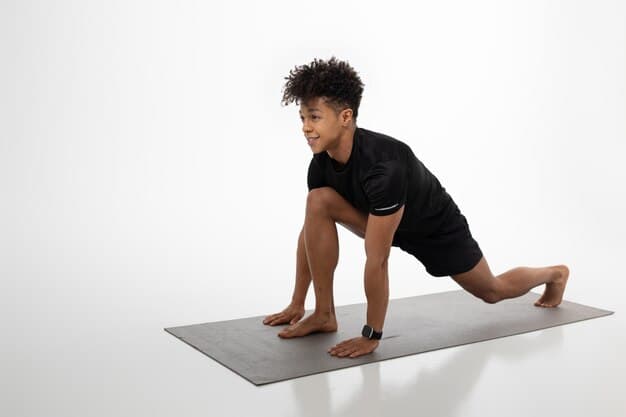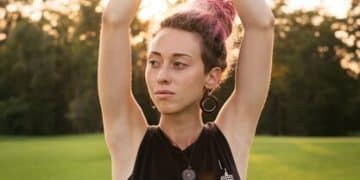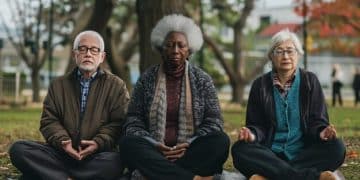Yoga for Athletes: 5 Poses to Boost Performance & Prevent Injuries

Yoga for athletes enhances performance and prevents injuries by improving flexibility, balance, and mental focus; incorporating targeted poses into training routines can optimize athletic capabilities and reduce the risk of common sports-related ailments.
Unlock your full athletic potential with the transformative power of yoga. This isn’t just about flexibility; it’s about building a stronger, more resilient body. Discover how yoga for athletes: Improve performance and prevent injuries with these 5 targeted poses can revolutionize your training regimen.
The Undeniable Benefits of Yoga for Athletes
Yoga, once considered a practice solely for flexibility and relaxation, is now gaining recognition as a powerful tool for athletes across various disciplines. It offers a multifaceted approach to enhancing physical and mental capabilities, leading to improved performance and injury prevention. Let’s explore the core benefits in detail.
Improved Flexibility and Range of Motion
One of the most well-known benefits of yoga is its ability to enhance flexibility. For athletes, this translates to a greater range of motion in their joints, which is crucial for optimal performance and reducing the risk of strains and tears.
Enhanced Balance and Stability
Many yoga poses require you to maintain balance, which strengthens the stabilizer muscles in your core, legs, and ankles. This improved stability leads to better body control and coordination, essential for sports that demand quick changes in direction or precise movements.
- Increased muscle strength and endurance contribute significantly to athletic performance.
- Improved focus and concentration, essential for making split-second decisions during competitions.
- Reduced stress and anxiety, which directly impacts performance and recovery.
Yoga offers athletes a unique combination of physical and mental conditioning. By incorporating yoga into their training, athletes can experience significant gains in performance, resilience, and overall well-being. It’s about building a stronger, more balanced, and focused athlete from the inside out.

Pose 1: Downward-Facing Dog (Adho Mukha Svanasana)
Downward-Facing Dog is a foundational yoga pose with a wealth of benefits for athletes. It’s a full-body stretch that improves flexibility, strengthens muscles, and calms the mind. This pose is a great way to start or end a workout, acting as both a warm-up and cool-down.
How to Perform Downward-Facing Dog
Start on your hands and knees, with your hands shoulder-width apart and your knees hip-width apart. Tuck your toes under and lift your hips up and back, forming an inverted V-shape with your body. Distribute your weight evenly between your hands and feet.
Benefits for Athletes
This pose stretches the hamstrings, calves, and spine, which are often tight in athletes. It also strengthens the arms, shoulders, and core, enhancing overall stability and power. Furthermore, it improves blood circulation and calms the nervous system, reducing stress and promoting relaxation.
- Increases flexibility in hamstrings and calves, reducing the risk of strains.
- Strengthens the core, essential for stability and power in athletic movements.
- Calms the nervous system, promoting relaxation and reducing stress.
Downward-Facing Dog is a versatile pose that can be modified to suit different levels of flexibility and strength. Whether you’re a seasoned yogi or new to the practice, incorporating this pose into your routine can significantly enhance your athletic performance and overall well-being. Its benefits extend beyond the physical realm, fostering mental clarity and focus, essential qualities for any athlete striving for success.
Pose 2: Warrior II (Virabhadrasana II)
Warrior II is a powerful standing pose that builds strength, stamina, and focus. It’s particularly beneficial for athletes because it strengthens the legs, opens the hips, and improves balance. This pose also cultivates mental fortitude, teaching athletes to stay grounded and centered under pressure.
Step-by-Step Instructions
Begin standing with your feet about 4 feet apart. Turn your right foot out 90 degrees and your left foot in slightly. Align your right heel with your left arch. Extend your arms out to the sides, parallel to the floor. Bend your right knee over your right ankle, keeping your thigh parallel to the floor. Gaze over your right hand.
How Warrior II Enhances Athletic Performance
Warrior II strengthens the quadriceps, hamstrings, and glutes, providing a solid foundation for explosive movements. It also opens the hips, increasing flexibility and range of motion. The focus required to maintain the pose enhances mental concentration and resilience, valuable assets in any sport.
- Strengthens legs, hips, and core, providing a solid foundation for athletic movements.
- Opens hips, improving flexibility and range of motion.
- Enhances mental focus and concentration, crucial for optimal performance.
Warrior II is more than just a physical pose; it’s a practice in cultivating inner strength and stability. By regularly practicing this pose, athletes can build a powerful and resilient body, while also developing the mental fortitude needed to overcome challenges and achieve their goals. It teaches the importance of grounding, balance, and unwavering focus, qualities that translate directly to success in sports and life.
Pose 3: Triangle Pose (Trikonasana)
Triangle Pose is a standing pose that stretches and strengthens the entire body. It’s particularly beneficial for athletes as it improves flexibility in the hamstrings, hips, and spine, while also strengthening the legs and core. This pose is a fantastic way to counteract the stiffness and imbalances that can result from repetitive athletic movements.
Executing the Triangle Pose
Start standing with your feet about 4 feet apart. Turn your right foot out 90 degrees and your left foot in slightly. Reach your right arm forward, then hinge at your hips and reach your right hand towards your right shin or ankle. Extend your left arm towards the ceiling, keeping your spine straight. Gaze up at your left hand.
Benefits for Athletic Performance
This pose stretches the hamstrings, which are often tight in athletes, improving flexibility and reducing the risk of strains. It also strengthens the legs and core, enhancing stability and power. Furthermore, it stimulates the abdominal organs, improving digestion and reducing bloating.
Triangle Pose promotes balance and stability, which are crucial for athletes in various sports. It stretches and strengthens key muscle groups, improving overall athletic performance and reducing the risk of injuries. The pose also encourages mindful movement and body awareness, helping athletes connect with their bodies and improve their technique.

Pose 4: Child’s Pose (Balasana)
Child’s Pose is a gentle resting pose that soothes the nervous system and promotes relaxation. While it may seem simple, it offers profound benefits for athletes, particularly in recovery and stress reduction. Let’s see how this works.
Performing Child’s Pose
Begin by kneeling on the floor with your knees hip-width apart and your toes touching. Sit back on your heels and then fold forward, resting your forehead on the floor. Extend your arms forward or rest them alongside your body. Relax your shoulders and breathe deeply.
Child’s Pose calms the mind and reduces stress, which is essential for athletes dealing with the pressures of training and competition. It gently stretches the hips, thighs, and ankles, relieving tension and promoting flexibility. Furthermore, it stimulates the abdominal organs, improving digestion and reducing bloating.
Pose 5: Bridge Pose (Setu Bandhasana)
Bridge Pose is a backbending pose that strengthens the glutes, hamstrings, and core. It’s an excellent choice for athletes looking to improve their power, stability, and posture. It also opens the chest and shoulders, counteracting the rounded posture that can develop from sitting for long periods or engaging in repetitive movements.
How to Properly Execute Bridge Pose
Lie on your back with your knees bent and your feet flat on the floor, hip-width apart. Press your feet into the floor and lift your hips up towards the ceiling, engaging your glutes and hamstrings. Clasp your hands together underneath your body and press your arms into the floor for added support. Hold the pose and breathe deeply.
How Bridge Pose helps Athletic Performance
Bridge Pose strengthens the posterior chain, which is crucial for generating power in athletic movements. It also opens the chest and shoulders, improving posture and breathing. Furthermore, it stimulates the abdominal organs, improving digestion and reducing bloating. The strengthening and stretching aspects improve mobility and agility, allowing you to move more freely.
- Strengthens the glutes and hamstrings, key muscles for explosive power and speed.
- Improves posture by opening the chest and shoulders, counteracting the effects of prolonged sitting or hunching.
- Enhances core stability, essential for maintaining balance and control during athletic activities.
Bridge Pose is a versatile pose that can be modified to suit different levels of strength and flexibility. By working on this pose, athletes can build a strong and resilient body, while also improving their posture and breathing. It’s about creating a foundation of strength and stability that supports optimal athletic performance and overall well-being. This pose is an important part of any athletic regimen, promoting core strength.
| Key Point | Brief Description |
|---|---|
| 💪 Strength Building | Yoga poses like Warrior II and Bridge Pose build key muscle strength. |
| 🧘 Flexibility Improvement | Poses such as Downward-Facing Dog and Triangle Pose increase flexibility. |
| 🧠 Mental Focus | Yoga enhances mental clarity, essential for athletic performance. |
| 🩹 Injury Prevention | Yoga helps prevent injuries by improving balance and flexibility. |
Frequently Asked Questions
▼
Athletes can benefit from practicing yoga 2-3 times per week, focusing on poses that target areas prone to injury in their sport. Consistency is key to seeing noticeable improvements in flexibility and strength.
▼
Hatha and Restorative yoga are often recommended for athletes due to their focus on basic poses, alignment, and relaxation techniques. Power yoga can also be beneficial for building strength and endurance.
▼
While yoga can contribute to strength building, it’s best used as a complement to traditional strength training. Yoga enhances flexibility and balance, while strength training focuses on building muscle mass and power.
▼
Athletes with certain injuries or physical limitations should avoid poses that put excessive strain on those areas. It’s always best to consult with a yoga instructor or physical therapist for personalized recommendations.
▼
Yoga incorporates mindfulness and breathing techniques that help athletes improve their focus and concentration. Regular practice can enhance their ability to stay present and make better decisions under pressure.
Conclusion
Incorporating these five targeted yoga poses into your training routine can significantly enhance your athletic performance and reduce the risk of injuries. Remember to listen to your body, progress gradually, and seek guidance from a qualified yoga instructor to maximize the benefits of this powerful practice.





